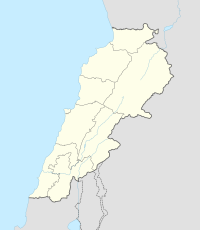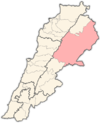Labweh
اللبوة | |
 Labweh village | |
| Location | 26 kilometres (16 mi) northeast ofBaalbek |
|---|---|
| Region | Bekaa Valley |
| Coordinates | 34°11′50″N36°21′09″E/ 34.197317°N 36.352392°E |
| Type | Tells |
| Part of | Settlements |
| History | |
| Founded | c. 6910 to 6780BC(from 3 limited samples) |
| Periods | PPNB |
| Cultures | Neolithic,Roman,Byzantine |
| Site notes | |
| Excavation dates | 1966, 1969 |
| Archaeologists | Diana Kirkbride,Lorraine Copeland,Peter Wescombe |
| Condition | Ruins |
| Public access | Yes |
Labweh(Arabic:اللبوة),Laboué,LabweorAl-Labwehis a village at an elevation of 950 metres (3,120 ft) on a foothill of theAnti-Lebanon MountainsinBaalbek District,Baalbek-Hermel Governorate,Lebanon.[1][2]
History
[edit]TheNeolithicsettlements represented at Labweh have been found dating to at least the 7th millennium BC.[3]It has been suggested that it was known to theEgyptiansas Lab'u, to theAssyriansas Laba'u and as Lebo-hamath to theHebrews.[4]This has been associated with the "entrance ofHamath"mentioned in theBooks of Kings[5]and theBook of Ezekiel,noted as the Northern border ofKing Solomon's territory,[6]but subsequently lost to the Syrians.Jeroboam II,king ofIsrael,is said to have "restored the territory of Israel from the entrance of Hamath to the Sea of theArabah(theDead Sea) ".[7]
Labweh in the originalSyriactongue means "heart" or "center", it also has been suggested to come from theArabicfor "lion" or "lioness". The village has several archaeological sites of interest including three old caves withRoman-Byzantinesarcophagiand the remains of a temple. There are also remains of a Byzantine bastion and a Roman dam suggested to date to the reign ofQueen Zenobia.Legend suggests that channels were carved through the rock to send water to her lands inPalmyra,Syria.[1]
In 1834,Burckhardt Barkernoted: "I came to a village called Labweh, after having passed an encampment ofTurkomansto the right of the road, at a place called Shaad. Labweh is at the foot of the range ofAnti-Libanuson the top of a hillock, near which passes a small stream which has its source in the adjoining mountains, and after flowing for several hours through the plain, falls into the basin from which springs theOrontes."[8] In 1838,Eli SmithnotedLebwehas aMetawilehvillage in theBaalbek District.[9]
Labweh Springs and Labweh River
[edit]The village is located on a hill 26 kilometres (16 mi) northeast ofBaalbek,which gives its name to the LabwehSpringsand Labweh River, one of the sources of theOrontes.[2]The Labweh river flows for approximately 20 kilometres (12 mi) through rocky desert. It then cascades into a lake and wider stream at another village called Er-Ras, considered to be the source of the Orontes. This flows onwards northeast, fed by numerous other streams from Lebanon's mountains.[10][11]
Archaeological sites
[edit]Soundings and analysis of archaeological sites in Labweh were made byLorraine Copelandand Peter Wescombe in 1966 with later excavations byDiana Kirkbridein 1969.[12]Tell Labweh,Tell Labweh SouthorLabwehI sits to the south of the village with another site to the north. The surface of Tell Labweh had been damaged by modern agriculture and it had been cut in half by road construction. Several burials were discovered inside the remains of rectangular buildings with white and red plaster floors. The remains of stone walls were found at lower levels and it is thought that the buildings may have used mud bricks at higher levels.[13]
Earlyneolithicfinds included a large number of fragments oflimestoneWhite Wareor "Vaisselle Blanche", along with laterpotterycalleddark faced burnished wareor DFBW. Only one vessel was reconstructed from the initial excavations; a bowl with combed finishing. Other shards included jars and bowls of a black, brown, or red colour, one showed astrawwiped finish normally found in sites further South in theJordan Valley.Others showed decorations such as chevrons, incised patterns, and corded impressions.[13]Flints were similar to those found atTell Ramadand includedByblospoints, hooks, scrapers, borers and burins. Burials were found within two houses, which were excavated and found to be similar to those in earlierPPNBandPPNAsites. A range ofsickleblades were found in thebasaldeposits and higher levels showing the evolution of denticulated and segmented cutting edges with similarities to those found at the oldest neolithic Byblos. Three initial samples wereRadiocarbon datedsuggesting a range of dates between 6780 and 6910BC;a date range covering only c. 130 years.[14]The range of finds at the site has however helped to reveal some aspects of the transition through neolithic stages.[13]
Tell Labweh Northis another large archaeological site, a few hundred meters north on the other side of the village and springs. Finely denticulated sickle blades,arrowheadsand trapezoidal, flakedaxesand fragments of whiteware along with burnished pottery with patterns and a fragment ofobsidianwere collected from the surface of the site. Most of the finds indicated settlement around the time of Tell Labweh (South) and Byblos.[13]Faunawould have included forest animals and numerous domesticated cattle, sheep, and goats.[15]
Roman temple
[edit]There are the ruins of aRoman templein the village that are included in a group ofTemples of the Beqaa Valley.[16] It was aprostyletype but only one block of the western wall remained visible. Modern construction built a house inside the temple.[17]There are around twenty temples located between Labweh andAin el-Baid.[18]
References
[edit]- ^abBa'albeck - Al-Hermal, Bekaa - Tourist Brochure
- ^abRoyal Geographical Society (Great Britain) (1837).The journal of the Royal Geographic Society of London.J. Murray. pp. 99–.Retrieved16 March2011.
- ^Halawi, Ayman; Messarra, Nasri; Bou Nader, Raymond (28 June 2020)."Arabic and Latin keyboard Choice in Lebanese Students' Discussions on WhatsApp".Lebanese Science Journal.22(1): 127–147.doi:10.22453/lsj-022.1.127-147.ISSN1561-3410.
- ^Mazar (Maisler), B. (1946). "Topographical Studies V: Lebo-Hamath and the Northern Boundary of Canaan".Bulletin of the Israel Exploration Society.12:91–102.
- ^1 Kings 8:65
- ^Daniel Isaac Block (March 1998).The Book of Ezekiel: chapters 25-48.Wm. B. Eerdmans Publishing. pp. 713–.ISBN978-0-8028-2536-0.Retrieved16 March2011.
- ^2 Kings 14:25:NKJVtranslation; cf.NIVtranslation, which refers to the Dead Sea
- ^Burckhardt Barker, 1837, p.99
- ^Robinson and Smith, 1841, vol 3, 2nd appendix, p.145
- ^Sir. William Smith, LLD, Ed. Dictionary of Greek and Roman Geography (1854)
- ^Society for the Diffusion of Useful Knowledge (Great Britain) (1842).Penny cyclopaedia of the Society for the Diffusion of Useful Knowledge.C. Knight. pp. 469–.Retrieved17 March2011.
- ^Zeidan Abdel-Kafi Kafafi (1982).The Neolithic of Jordan (East Bank).Papyrus Druck.Retrieved16 March2011.
- ^abcdMoore, A.M.T. (1978).The Neolithic of the Levant.Oxford University, Unpublished PhD Thesis. pp. 192–198.
- ^University of Cologne - Radiocarbon Context Database
- ^Richard H. Meadow; Melinda A. Zeder (1978).Approaches to faunal analysis in the Middle East.Peabody Museum of Archaeology and Ethnology, Harvard University.ISBN978-0-87365-951-2.Retrieved16 March2011.
- ^George Taylor (1967).The Roman temples of Lebanon: a pictorial guide.Dar el-Machreq Publishers.Retrieved28 October2012.
- ^Othmar Keel (1997).The Symbolism of the Biblical World: Ancient Near Eastern Iconography and the Book of Psalms.Eisenbrauns. pp. 158–.ISBN978-1-57506-014-9.Retrieved28 October2012.
- ^Baal: Bulletin d'archéologie et d'architecture libanaises.Direction Générale des Antiquités. 2001.Retrieved28 October2012.
Literature
[edit]- Burckhardt Barker, W.(1837)."Notes Made on a Journey to the Source of the River Orontes in Syria, in September, 1834".Journal of the Royal Geographical Society of London.7:95–102.
- Copeland, Lorraine and Westcombe, Peter, Inventory of Stone Age Sites in Lebanon Part 2: North - South - East Central Lebanon Volume 42 (Pages 1–174) Mélanges de l'Université Saint-Joseph (Beirut Lebanon), 1966.
- Kirkbride, Diana, Early Byblos and the Bakaa, Volume 45 (Pages 43–60), Mélanges de l'Université Saint-Joseph (Beirut Lebanon), 1969.
- Robinson, E.;Smith, E.(1841).Biblical Researches in Palestine, Mount Sinai and Arabia Petraea: A Journal of Travels in the year 1838.Vol. 3. Boston:Crocker & Brewster.
External links
[edit]- Lebwe temple on lebanon
- Laboueh,Localiban



